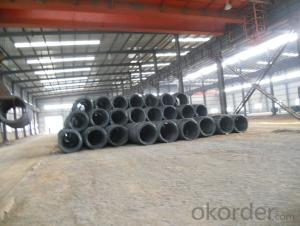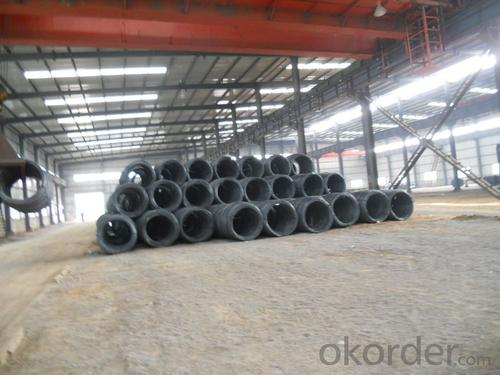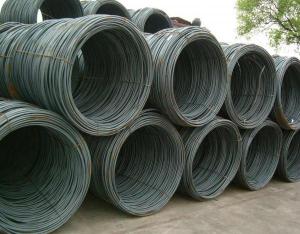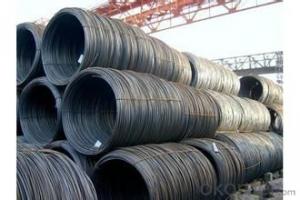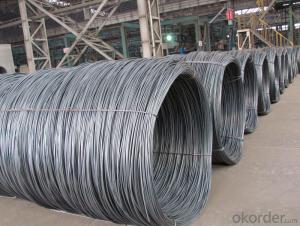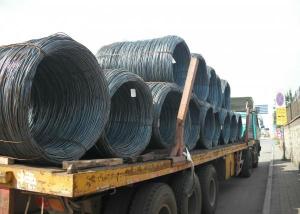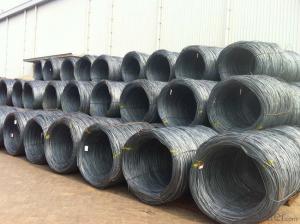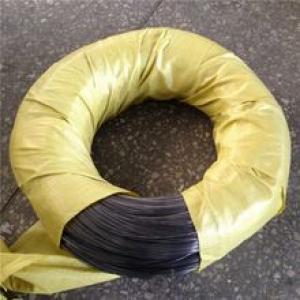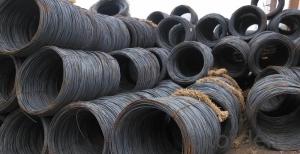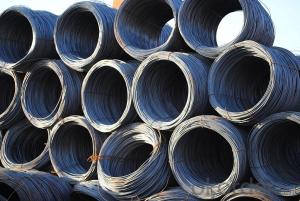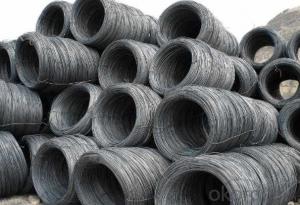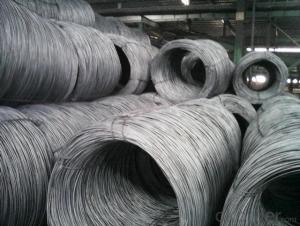Steel and Metal Wire Rod of Low Carbon Steel
- Loading Port:
- China main port
- Payment Terms:
- TT or LC
- Min Order Qty:
- 100 m.t.
- Supply Capability:
- 10000 m.t./month
OKorder Service Pledge
OKorder Financial Service
You Might Also Like
Specification
OKorder is offering Steel and Metal Wire Rod of Low Carbon Steel at great prices with worldwide shipping. Our supplier is a world-class manufacturer of steel, with our products utilized the world over. OKorder annually supplies products to African, South American and Asian markets. We provide quotations within 24 hours of receiving an inquiry and guarantee competitive prices.
Product Applications:
Steel and Metal Wire Rod of Low Carbon Steel are ideal for structural applications and are widely used in reinforcement of reinforced concrete and welded structure or reprocessed (roberts , nail, etc.) materials, especially used to produce wire drawing, welding electrode, nails, spring, electronic, precise machinery parts and so on.
Product Advantages:
OKorder's Steel and Metal Wire Rod of Low Carbon Steel are durable, strong, and wide variety of sizes.
Main Product Features:
· Premium quality
· Prompt delivery & seaworthy packing (30 days after receiving deposit)
· Can be recycled and reused
· Mill test certification
· Professional Service
· Competitive pricing
Product Specifications:
Steel Grade: Q195/235, SAE1006-1018B
Standard: ASTM, GB
Diameter: 5.5mm, 6.5mm, 7mm,8mm,9mm,10mm,12mm,14mm
Type: in coil, coil weight around 2MT
Alloy or Not: Alloy
Technique: Hot Rolled
Place of Origin: China Mainland
Surface: round, no twisted, light and smooth
Grade | Chemical Composition(%) | |||||
C | Mn | Si | S | P | B | |
Q195B | 0.06~O.12 | 0.25~O.50 | ≤0.30 | ≤0.050 | ≤0.045 | >0.0008 |
Mechanical properties | ||||||
Yield strength(N/mm2) | Tensile strength(N/mm2) | Elongation(%) | ||||
≥195 | 315-430 | ≥33 | ||||
Grade | Chemical Composition(%) | |||||
C | Mn | Si | S | P | B | |
Q235B | 0.12~O.2 | 0.3~O.701 | ≤0.30 | ≤0.045 | ≤0.045 | >0.0008 |
Mechanical properties | ||||||
Yield strength(N/mm2) | Tensile strength(N/mm2) | Elongation(%) | ||||
235 | 375-500 | ≥26 | ||||
FAQ:
Q1: Why buy Materials & Equipment from OKorder.com?
A1: All products offered byOKorder.com are carefully selected from China's most reliable manufacturing enterprises. Through its ISO certifications, OKorder.com adheres to the highest standards and a commitment to supply chain safety and customer satisfaction.
Q2: How do we guarantee the quality of our products?
A2: We have established an advanced quality management system which conducts strict quality tests at every step, from raw materials to the final product. At the same time, we provide extensive follow-up service assurances as required.
Q3: How soon can we receive the product after purchase?
A3: Within three days of placing an order, we will arrange production. The normal sizes with the normal grade can be produced within one month. The specific shipping date is dependent upon international and government factors, the delivery to international main port about 45-60days.
Q4: How many tons of steel products could be loaded in containers?
A4: Usually the steel products are delivered by bulk vessel because of the large quantity and the freight. However, there are no bulk vessel enter some seaports so that we have to deliver the cargo by containers. The 6m steel product can be loaded in 20FT container, but the quantity is changed according to the size, usually from 18tons to 25tons.
Images:


- Q: What are the common inspection methods for steel wire rod?
- The common inspection methods for steel wire rod include visual inspection, dimensional inspection, mechanical testing, surface inspection, and chemical analysis. Visual inspection involves checking for any visible defects or irregularities in the wire rod. Dimensional inspection ensures that the wire rod meets the specified dimensions and tolerances. Mechanical testing involves conducting tests like tensile strength, yield strength, and elongation to determine the mechanical properties of the wire rod. Surface inspection is done to detect any surface defects such as cracks, scratches, or corrosion. Chemical analysis is performed to verify the composition and quality of the steel wire rod.
- Q: How is steel wire rod used in the manufacturing of wire harnesses?
- Steel wire rod is used in the manufacturing of wire harnesses as it serves as the primary material for the conductive wires within the harness. The wire rod is first drawn into the desired diameter and then processed further to remove any impurities or surface defects. These high-quality wires are then twisted, braided, or insulated to create the necessary configuration for the wire harness, providing the required strength, flexibility, and electrical conductivity. Overall, steel wire rod plays a crucial role in ensuring the durability and performance of wire harnesses in various industries, including automotive, aerospace, and electronics.
- Q: What are the major barriers to entry in the steel wire rod market?
- The major barriers to entry in the steel wire rod market can be attributed to several factors. Firstly, the high capital requirements present a significant barrier for new entrants. Establishing a steel wire rod production facility requires substantial investment in machinery, equipment, and infrastructure. Additionally, the costs associated with raw materials, such as iron ore and scrap metal, further add to the financial burden. This high capital requirement limits the entry of new players, as they may struggle to secure the necessary funds to compete with established industry participants. Secondly, economies of scale play a crucial role in the steel wire rod market. Existing manufacturers often benefit from a larger production base, enabling them to achieve cost efficiencies through bulk purchasing, streamlined production processes, and distribution networks. This advantage makes it difficult for new entrants to compete on a cost basis, as they would need to achieve similar economies of scale to remain competitive. Furthermore, the steel wire rod market is highly competitive, with a few dominant players holding significant market share. These established companies have strong brand recognition, longstanding customer relationships, and established distribution channels. This makes it challenging for new entrants to gain market share and attract customers away from these well-established players. Regulatory barriers also pose challenges for new entrants. The steel industry is subject to various government regulations and compliance requirements, including environmental regulations and safety standards. These regulations can be complex and costly to navigate, adding further barriers to entry for potential new players. Lastly, technological advancements and innovation are essential in staying competitive in the steel wire rod market. Existing manufacturers often have access to advanced technology and research and development capabilities, allowing them to produce higher quality products and drive efficiency improvements. New entrants may struggle to match these technological capabilities, making it difficult to gain a competitive edge. In summary, the major barriers to entry in the steel wire rod market include high capital requirements, economies of scale, strong competition from established players, regulatory compliance, and technological advancements. These barriers make it challenging for new entrants to penetrate the market and establish a foothold.
- Q: How are steel wire rods used in the manufacturing of fasteners?
- Steel wire rods are an essential component in the manufacturing of fasteners. Fasteners, such as bolts, screws, and nails, are used to join or secure two or more objects together. Steel wire rods serve as the raw material for fasteners, providing the necessary strength and durability. The manufacturing process begins with steel wire rods, which are usually made from carbon or alloy steel. These rods are typically produced through a hot rolling process, where the steel is heated and then passed through a series of rollers to achieve the desired shape and size. The resulting wire rods are then further processed to meet the specific requirements of fastener production. One of the primary uses of steel wire rods in fastener manufacturing is for the production of bolts and screws. The wire rods are typically cut into specific lengths and then undergo a series of operations, such as heading, threading, and heat treatment. Heading involves forming the head of the bolt or screw, while threading creates the ridges or grooves that allow them to be screwed into place. Heat treatment is often employed to enhance the strength and hardness of the fastener. Steel wire rods are also used in the production of nails. The rods are first drawn to the desired diameter and then cut into appropriate lengths. The ends of the wire are sharpened, and the nails are formed by a process called pointing. Pointing involves creating a sharp tip on one end of the wire, which allows the nail to penetrate materials easily. In addition to bolts, screws, and nails, steel wire rods are used in the manufacturing of other fasteners, such as rivets, cotter pins, and clips. These fasteners are essential in various industries, including construction, automotive, aerospace, and furniture. Overall, steel wire rods play a crucial role in the manufacturing of fasteners by providing the necessary strength, durability, and versatility required for joining and securing objects together. They serve as the foundation for the production of various fastener types, enabling the construction of strong and reliable structures.
- Q: How is steel wire rod used in the production of tire reinforcement materials for vehicles?
- Steel wire rod is used in the production of tire reinforcement materials for vehicles as it provides high tensile strength, durability, and resistance to deformation. The steel wire rod is typically processed into thin filaments or cords which are then embedded in the tire's rubber compound to enhance its structural integrity, improve grip, and increase overall performance. These steel reinforcements help the tire withstand the forces exerted during acceleration, braking, and cornering, ensuring a safer and more reliable driving experience.
- Q: What are the main factors influencing the choice of steel wire rod order cancellation policy?
- The main factors influencing the choice of steel wire rod order cancellation policy include market conditions, supply and demand dynamics, contractual agreements, financial implications, and customer relationships.
- Q: What are the different types of steel wire rods?
- There are several different types of steel wire rods, including carbon steel wire rods, alloy steel wire rods, stainless steel wire rods, and galvanized steel wire rods. Each type has its own unique properties and is used for various applications, such as construction, automotive, and electrical industries.
- Q: How are steel wire rods used in the manufacturing of wire baskets for storage and organization?
- Steel wire rods are used in the manufacturing of wire baskets for storage and organization by being shaped and woven into the desired basket structure. The rods provide strength and durability to the baskets, allowing them to hold various items securely. Additionally, they can be coated or galvanized to prevent rusting, ensuring longevity.
- Q: How are steel wire rods used in the manufacturing of screws and bolts?
- Steel wire rods are used in the manufacturing of screws and bolts as they provide the raw material for shaping and forming these fasteners. The rods are typically cold drawn or hot rolled to produce the required diameter and length for the specific screw or bolt size. They are then cut, threaded, and heat-treated to enhance their strength and durability. Finally, the rods are further processed to create the screw or bolt head, ensuring a secure and reliable fastening solution.
- Q: What are the different types of steel wire rod dimensional inspection methods?
- In the industry, there are multiple commonly utilized methods for inspecting the dimensions of steel wire rods. These methods are employed to ensure that the steel wire rods meet the specified requirements and are suitable for their intended applications. Some of the primary inspection methods for dimensions include: 1. Caliper measurement: This method involves the use of a caliper tool to measure the diameter of the steel wire rod. It is a basic yet effective technique that provides quick and accurate measurements. 2. Micrometer measurement: Micrometers, commonly used in the steel industry, offer more precise measurements compared to calipers. They are typically used to measure the diameter of the wire rod. 3. Optical measurement: Optical measurement methods utilize cameras, lasers, or other optical devices to capture images or collect data about the dimensions of the steel wire rod. These methods are non-contact and provide highly accurate measurements. 4. Laser scanning: Laser scanning technology is frequently employed to measure the profile or shape of steel wire rods. This method involves scanning a laser beam across the surface of the wire rod and analyzing the reflected beam to determine the dimensions. 5. Ultrasonic measurement: Ultrasonic measurement methods utilize sound waves to measure the dimensions of the steel wire rod. By sending ultrasonic waves through the material and measuring the time it takes for the waves to bounce back, the dimensions can be determined. 6. Coordinate measuring machine (CMM): CMMs are advanced measurement systems that utilize probes and computer software to measure the dimensions of the steel wire rod. These machines offer highly accurate and precise measurements. 7. Visual inspection: Visual inspection is a straightforward method that involves visually examining the steel wire rod for any defects or deviations from the specified dimensions. This method is often used as an initial inspection before employing more complex measurement techniques. These represent just a few of the numerous methods used to inspect the dimensions of steel wire rods. Each method has its own advantages and limitations, and the choice of the appropriate method depends on factors such as the required level of accuracy, the complexity of the wire rod's shape, and the available resources and equipment.
Send your message to us
Steel and Metal Wire Rod of Low Carbon Steel
- Loading Port:
- China main port
- Payment Terms:
- TT or LC
- Min Order Qty:
- 100 m.t.
- Supply Capability:
- 10000 m.t./month
OKorder Service Pledge
OKorder Financial Service
Similar products
Hot products
Hot Searches
Related keywords
